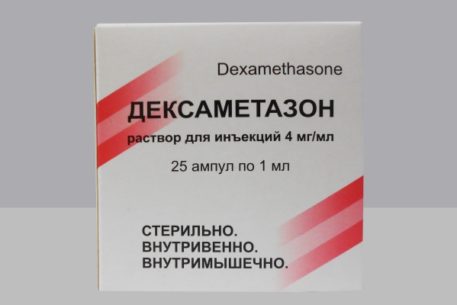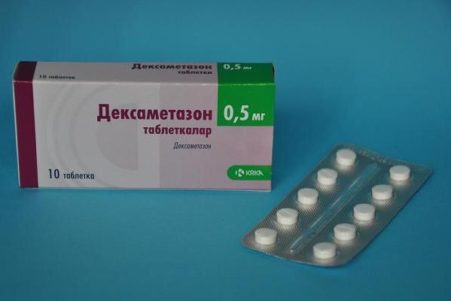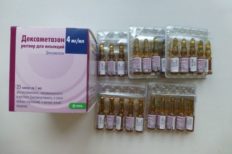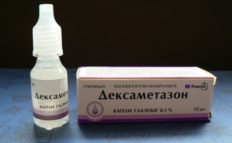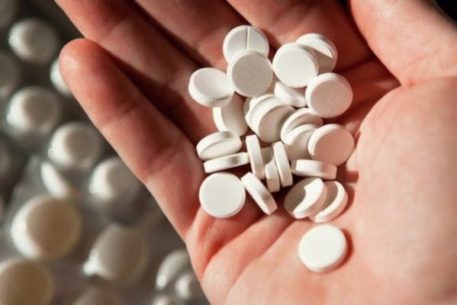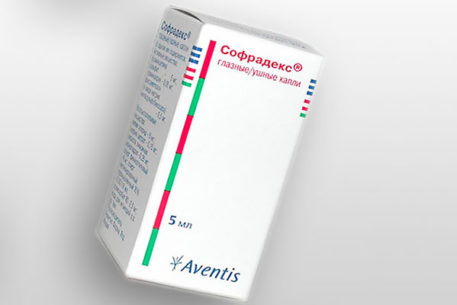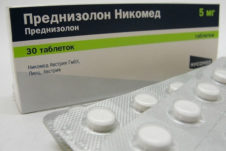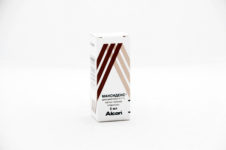Dexamethasone is a hormonal drug that is considered in modern medicine as one of the vital pharmaceuticals belonging to the group of synthetic glucocorticosteroids. Dexamethasone is able to penetrate the tissues of all organs and systems, including the brain and nervous system, and affect the entire body. In severe conditions - shock, acute systemic allergies, severe inflammation, pathological immune reactions, the medicine can save a life.
Material Content:
- 1 The composition of the release form
- 2 Pharmacological properties and pharmacokinetics
- 3 Why is the drug prescribed?
- 4 Instructions for use Dexamethasone
- 5 Use during pregnancy and lactation
- 6 Can I drink alcohol while taking the drug
- 7 Drug Interactions with Other Drugs
- 8 Contraindications, side effects and overdose
- 9 Dexamethasone Analogs
The composition of the release form
For the treatment of various types of diseases, Dexamethasone is produced in 4 dosage forms, the therapeutic basis of which is dexamethasone sodium phosphate.
This substance is a synthetic analogue of the natural steroid hormone that the adrenal glands produce in the body.
The main forms:
- Tablets of 0.5 mg (0.5 mg of active ingredient) in a pack of 10 units.
- Injection solution (0.4%) in 1 ml ampoules containing 4 mg of active substance (5 or 25 units per pack).It is used to inject into the muscle, vein (stream or drip), into the joint, into the soft tissues surrounding it, into the fiber of the eyeball.
- Dexamethasone eye drops (ear) 10 ml with an active substance concentration of 0.1% (1 mg in 1 ml).
- Eye ointment - 2.5 g tube
All forms of the drug as auxiliary components contain substances that are necessary for stabilization, shaping and transportation of dexamethasone to the painful focus, as well as preservatives and additives that facilitate the absorption of the drug.
Each medical form has its purpose in use, certain indications and contraindications, so you should not engage in treatment yourself - only a specialist is able to develop the desired treatment regimen, calculate the dose and frequency of use.
The medicine is prescription, where the name of the drug in Latin is designated as Dexamethasoni.
Pharmacological properties and pharmacokinetics
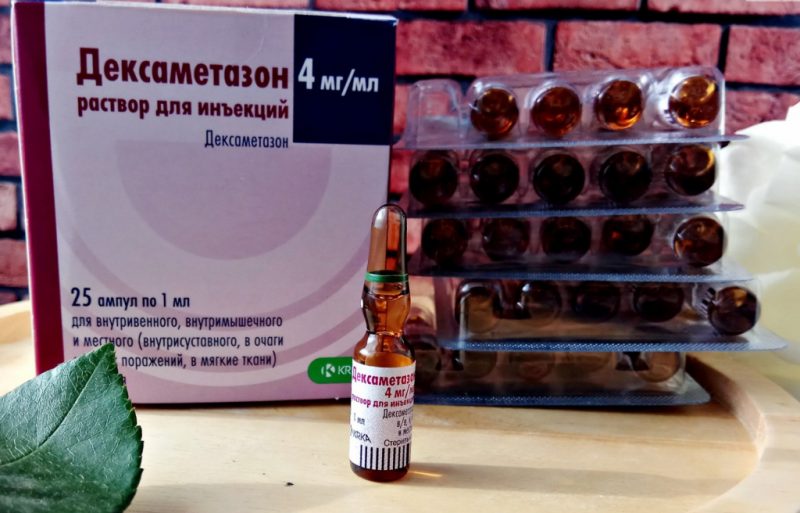
Healing properties
The mechanism of the therapeutic effect of the drug is based on its ability to create a high concentration of the component in the blood and foci of inflammation, penetrate all tissues and exert an effect at the cellular level.
This allows the active substance to work in the brain and nerve tissues, relieve cerebral and pulmonary edema with hemorrhage, poisoning, injuries, and tumors, leading the patient out of a life-threatening shock state, inhibiting the course of cancer processes, and eliminating the manifestations of acute allergies.
Glucocorticosteroid activates a series of processes that lead to a decrease in the permeability of the walls of blood vessels, strengthen the protection of cell walls and block inflammation at any stage of development.
Suppressing the acute reaction of the immune system to allergens, the drug stops the development of an allergic reaction, including anaphylactic shock, reduces the degree of swelling of the mucous membranes of the respiratory organs, bronchi, restoring air flow during swelling of the larynx or asthmatic attack.
At the same time, the drug inhibits the production of histamine, stopping the pathological manifestations of allergies.
Slows down the formation of cicatricial changes in the tissues of various organs.
Absorption and excretion from the body
The corticosteroid is actively and almost completely absorbed not only after injection, but also after internal administration. The bioavailability or amount of a therapeutic substance reaching the focus of exposure is 77 - 79%, due to which the therapeutic effect of the drug is maximum.
In the blood, 65 - 70% of dexamethasone binds to the transport protein transcortin, which provides a high concentration of the drug in the blood. With blood flow, the protein delivers dexamethasone throughout the body, penetrating into the intracellular spaces of tissues.
The greatest amount of active substance in the blood, providing the maximum therapeutic effect, is observed in the range from 40 to 90 minutes, depending on the method of application.
The active substance is processed by liver enzymes to inactive intermediates. It is removed from the body with urine and in small quantities (about 10%) is excreted by the intestines. A small amount of dexamethasone passes into breast milk, which should be considered when prescribing the drug to a nursing mother.
Why is the drug prescribed?
The action of the drug is used in many diseases of internal organs, systemic, autoimmune pathologies, diseases of the joints, eyes, skin and in many other areas of medicine.

The list of pathological conditions in which injection or Dexamethasone tablets are required includes:
- life-threatening shock conditions of all forms, including pain shock, toxic, cardiogenic, allergic, postoperative, blood transfusion (after blood transfusion);
- swelling of brain tissue (with hemorrhage, meningitis, tumor, encephalitis, trauma, surgery);
- an attack of bronchial asthma or long-term asthmatic status;
- lung pathology: berylliosis, tuberculosis, alveolitis, pneumonia, Leffler's syndrome (resistant to other medical devices);
- allergic reactions: urticaria, Quincke's edema, hay fever, allergy to drugs and products, serum sickness;
- endocrine disorders - adrenal insufficiency, thyroid disease, thyrotoxic crisis, thyroiditis, adrenogenital syndrome;
- autoimmune diseases - rheumatic heart disease, multiple sclerosis, systemic lupus erythematosus, pemphigus, scleroderma, systemic vasculitis;
- pain with inflammation of the reproductive organs, including prostatitis; various types of myositis;
- intractable skin diseases - eczema, dermatitis of various types, psoriasis, toxidermia, Lyell and Stevens-Johnson syndromes, discoid lupus erythematosus, keloid scars (local application);
- allergic and inflammatory eye damage: scleritis, corneal ulcer, various types of conjunctivitis (except purulent), uveitis, keratitis, blepharitis, inflammation of the optic nerve, ophthalmopathy against diabetes mellitus;
- swelling of the larynx and glottis with acute croup;
- inflammation of the joints of various types: arthritis of various forms, osteoarthritis, polyarthritis, ankylosing spondylitis, bursitis, tendosynovitis and others;
- hematopoiesis disorders: Addison's disease, lymphoma, agranulocytosis, anemia of different origin, thrombocytopenia;
- critical conditions in case of damage to the gastrointestinal system: enteritis, including granulomatous, hepatitis and hepatic coma, ulcerative colitis;
- allergic-toxic reaction with massive helminthic aggression;
- damage to the esophagus and stomach during poisoning with alkalis, acids to suppress inflammation and prevent scarring;
- acute renal pathology - glomerulonephritis, nephrotic syndrome;
- malignant processes in the lungs, leukemia, lymphocytic leukemia, myeloma;
- nausea and vomiting with cytostatics.
Instructions for use Dexamethasone
The dexamethasone treatment regimen and dosing regimen are established only by the attending physician in order to obtain the maximum therapeutic effect with the minimum risk of unwanted adverse reactions.
Pills
Usually prescribed for a chronic course of pathology or after removal of an acute condition.
The dose is determined for each patient separately, taking into account the nature and severity of the disease, the planned duration of the course, age, drug tolerance and patient response.
The usual minimum effective dose for adults per day is 0.5 to 9 mg. A small dose is taken at a time, a large dose is divided into 3 to 4 doses. The greatest amount of dexamethasone per day should not exceed 10 - 15 mg.
The average maintenance dose per day is 0.5 to 3 mg.
With long-term use of the drug in a large dose, the drug is combined with food. In this case, between meals, it is desirable to use means that reduce gastric acidity (antacids).
After improving the patient's condition, the dose should be gradually reduced - every 3 days by 0.5 mg to a maintenance dose.
The duration of the course of use ranges from 3 to 5 days to several months.
It is unacceptable to abruptly stop treatment with Dexamethasone, so as not to cause withdrawal syndrome,
which is expressed in exacerbation of the underlying disease and painful manifestations of withdrawal symptoms (weakness, weight loss, vomiting, diarrhea, drop in blood sugar and pressure, muscle pain, fever).
Dosage for children
Young patients are prescribed in accordance with body weight or body area, age and severity of the pathological process.
Estimated daily dose of children 0.0833 - 0.333 mg per 1 kilogram of body weight of the child. Thus, according to the calculation, a child weighing 25 kg can receive a maximum of 0.333 x 25 = 8.36 mg of the drug per day, divided into 3-4 doses. The minimum dose that will give a therapeutic effect for a small patient with such a weight is 0.0833 x 25 = 2.08 mg.
More precisely, the children's dose is calculated according to the surface area of the child’s body at the rate of 0.0025 - 0.0001 mg per 1 square meter per day in 3 to 4 doses, depending on age.
Injections
In systemic diseases, dexamethasone injections are done inside the muscles, or injected intravenously, which is preferable in life-threatening situations when the patient’s life is at high risk. The solution immediately enters the bloodstream, providing a quick therapeutic effect.
For emergency short-term or one-time use of the drug, only intolerance to any of the substances in the composition of Dexamethasone is considered a contraindication. In critical situations, the side effects of the drug are neglected.
Adults with acute and emergency conditions per day can be administered 3 to 4 times, 4 to 20 mg each. In the acute phase of the pathology, as well as at the beginning of therapy, higher doses of the corticosteroid are used. The highest dose is 80 mg, but in critical cases it is higher.
Children's doses for intramuscular administration are calculated by the weight of the child at the rate of 0.02776 - 0.16665 mg per kilogram of body weight after 12-24 hours.
The duration of injection with a gradual dose reduction usually does not exceed 3-4 days, after which the patient is transferred to the administration of tablets in a maintenance dose.
Eye and ear drops
In acute inflammation, patients older than 12 years of age receive 48 ml of ophthalmic solution for 1 to 2 drops 4 to 5 times a day for 48 hours. When the degree of inflammation decreases, treatment is continued for another 4-6 days, reducing the frequency of instillation up to 3 times a day.
In chronic processes, the drug is used twice a day for no longer than 20 to 40 days.
In case of allergic eye damage, similar doses are used up to 5 times a day for 48 hours, then gradually lower the frequency of instillation to 2 times a day and the treatment is canceled for 7-12 days.
Patients 6 to 12 years of age to eliminate inflammatory and allergic phenomena are administered 1 drop per eyelid up to 4 times a day for no longer than 10 days.
The solution is used from 8 days after cataract surgery, retinal detachment, strabismus up to 4 times a day for 2 to 4 weeks.
With inflammation of the ear (otitis media) of a non-viral nature, 3-4 drops are dropped into a sore ear in a warm form (for children 1-2) three times a day.
Lenses are removed before instilling. You can wear them only after 15 minutes.
Dexamethasone Eye Ointment
It is used for the same indications as ophthalmic drops in patients from 6 years old. A strip of ointment 10-15 mm long is carefully laid over the lower eyelid 3 times a day. The maximum duration of treatment is no more than 20 days.
Use during pregnancy and lactation
A study on small mammals revealed that Dexamethasone, like many other hormonal agents, penetrates the placenta into the tissues of the embryo and can lead to early death of the fetus and malformations of the fetus. The class of drug action on the fetus is C (according to the FDA).

Therefore, dexamethasone is used during pregnancy only if there is a threat to life for the mother.
If the pregnant woman received Dexamethasone, monitoring the health of the infant is necessary after childbirth - because the baby can be diagnosed with adrenal dysfunction, which requires immediate intensive treatment.
Since the drug penetrates into breast milk, nursing mothers need to switch to artificial feeding or refuse the drug.
With long-term use of ointment or drops, a partial absorption of the drug into the blood occurs. Therefore, these dosage forms are allowed to be used by expectant mothers only after 12 weeks of gestation, in very short courses of up to 3 days and in minimal doses.
During lactation, ointment and drops can be treated for no longer than 7-10 days.
Can I drink alcohol while taking the drug
Dexamethasone treatment is incompatible with the use of alcohol, otherwise the consequences of concurrent use will be very serious.
High probability of such severe manifestations as:
- indomitable diarrhea;
- partial loss of vision;
- abdominal pain, vomiting;
- acute soreness at the injection site;
- redness of the skin on the chest, urticaria, rash of blackheads on the face;
- ulceration of the mucous membrane of the digestive organs;
- internal bleeding.
If the patient has a serious alcohol dependence and is not able to give up alcohol for the duration of therapy, other drugs are required.
Drug Interactions with Other Drugs
The combination of Dexamethasone and non-hormonal anti-inflammatory pharmaceuticals (Aspirin, Paracetamol) increases the likelihood of formation or deepening of ulcers of the digestive organs.
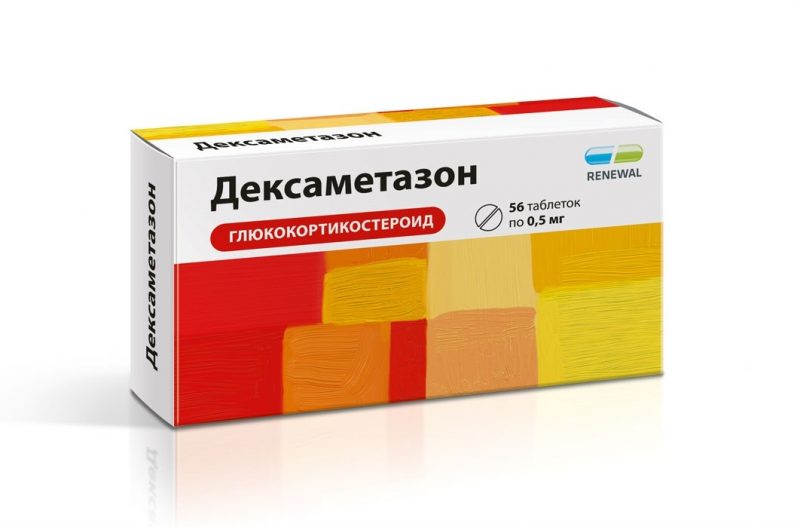
The effect of a corticosteroid is reduced with parallel use:
- antacids that reduce the absorption of the healing substance in the stomach;
- growth hormone;
- drugs from the CYPZA4 isoenzyme inducer series (for example, phenobarbital, phenobarbital, rifabutin, rifampicin, carbamazepine);
- aminoglutethimide and ephedrine.
With the parallel use of Dexamethasone is capable of:
- reduce the therapeutic effects of insulin, hypoglycemic drugs, drugs for high blood pressure, praziquantel and diuretics-natriuretics;
- enhance the action of Heparin, Albendazole.
- increase potassium excretion when combined with diuretics; affect the effect of coumarin-based anticoagulants;
Ketoconazole antifungal agents, birth control pills, macrolide antibiotics can lengthen the urinary excretion of dexamethasone and increase the frequency and extent of adverse reactions.
It is strictly forbidden to combine Dexamethasone with Ritodrin during childbirth - there is a high risk of pulmonary edema in a pregnant woman and death.
The combination of a medication with thalidomide can provoke the development of Lyell's syndrome, with anticholinergics - glaucoma, with antipsychotic drugs and Azathioprine - cataracts; with cardiac glycosides - arrhythmias.
The combination with anabolic steroids, androgens, contraceptives, estrogens can cause increased hair growth of the face, chest, swelling, the development of acne.
The use of antiviral vaccines in parallel with Dexamethasone therapy increases viral aggressiveness against a background of decreased immunity.
Contraindications, side effects and overdose
Contraindications
If Dexamethasone is urgently needed to save a life, all contraindications (except for drug intolerance), and probable adverse reactions are ignored.
If the situation is not life-threatening, the following contraindications are considered:
- special sensitivity; pregnancy, lactation;
- recent heart attack, myocardial, kidney, liver failure, diverticulitis;
- persistent increase in blood pressure;
- diabetes mellitus, thyrotoxicosis, obesity of 3-4 degrees, hypothyroidism, Itsenko-Cushing's disease;
- HIV, syphilis;
- 2 months before and 2 weeks after vaccination;
- lymphadenitis after BCG vaccine;
- acute psychotic conditions.
With a high degree of caution:
- systemic mycosis, osteoporosis;
- convulsive conditions;
- parasitic, bacterial and viral infectious pathologies, including various types of herpes, chickenpox, measles, amoebiasis, strongyloidosis (even if suspected), active tuberculosis.
For any serious infections, injections and tablets of Dexamethasone can be prescribed only with the simultaneous specific treatment of these diseases.
Contraindications for intraarticular injection:
- tendency to bleeding;
- intraarticular bone fracture;
- infection, osteoporosis, instability, deformation in the joint, bone destruction, ankylosis;
- surgical intervention (arthroplasty);
- joint bone necrosis;
- low efficiency after 2 previous injections.
Contraindications for local forms (ointment, drops):
- damage to the eyes with tubercle bacillus, fungus, viruses, including herpes;
- glaucoma;
- acute suppuration of eye structures (if antibiotic treatment is not carried out);
- trauma and ulcer of the cornea, the period after the removal of a foreign object;
- hole in the eardrum.
Important! Dexamethasone ointment and drops can reduce the severity of manifestations with the development of bacterial and fungal infections of the ears and eyes.
Therefore, after clarifying the diagnosis and identifying the infection, the drug should be used with appropriate antimicrobial treatment.
Side effects
The hormonal agent has a profound effect on all body systems. The task of the attending physician is to minimize the risk, frequency and severity of adverse reactions with a high therapeutic effect of the drug.
Undesirable manifestations depend on the duration of the course, dosages, age and condition of the patient.
Basic adverse events:
- allergic rashes, skin itching, urticaria, swelling on the face, respiratory distress, bronchospasm, anaphylactic shock;
- anxiety, loss of orientation, depressive, paranoid or euphoria;
- double vision, visual disturbances, pain in the head due to an increase in intracranial pressure, characteristic of a rapid decrease in dose;
- insomnia, dizziness;
- persistent increase in blood pressure;
- weakening of the myocardium, arrhythmias;
- potassium deficiency and cardiac disorders associated with hypokalemia;
- decreased adrenal function, development of diabetes mellitus, Itsenko-Cushing's syndrome, excessive hair growth, monthly cycle disorder, developmental delay in children;
- a sharp increase in blood viscosity and thrombosis;
- nausea, vomiting, ulceration of the digestive organs, gastritis, pancreatitis, colitis;
- frequent infections amid depression of immunity;
- osteoporosis, abnormal fractures, joint and muscle pain, necrosis of the femoral head, tendon rupture;
- acne, sweating, dry skin, slow healing of lesions;
- swelling of the extremities, weight gain;
- sharp deterioration of vision (with injections in the area of the face, neck and head);
- increased pain during injection into the joint;
- burning, itching of the mucous membranes and skin (ointment and drops), with treatment longer than 20 days, allergies, glaucoma and cataracts may develop, and visual function may decrease.
Drivers and employees who require increased concentration should be careful when treating with Dexamethasone, since attention is impaired when it is taken.
Overdose
Excessive doses of a corticosteroid or long-term treatment can lead to an overdose, which manifests itself in an increase in unwanted adverse reactions.
The drug is immediately canceled and the symptoms of overdose are eliminated with the help of drugs that can relieve certain manifestations.
With long-term therapy, constant monitoring of the development of children, periodic examination of the organs of vision, monitoring of intraocular, intracranial pressure, sugar and blood coagulation, the functions of the adrenal glands and the hypothalamic-pituitary system are required.
Dexamethasone Analogs
Synonyms are medicines with the same active component as in Dexamethasone and a similar therapeutic effect: Dexamethasone-Vial, Dexamethasone-Ferein, eye drops - Dexamethasone Long, Maxidex, Oftan Dexamethasone, Ozurdeks.
Analogs with a similar effect, but with a different composition:
- drops with Dexamethasone and other active components: Sofradex, Dexon;
- Prednisolone is a corticosteroid treatment with a similar but weaker therapeutic effect.


